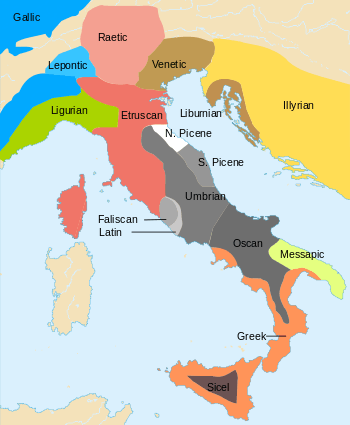Venetic language
| Venetic | |
|---|---|
| Region | Northeastern Italy |
| Extinct | attested 5th–1st century BC[1] |
|
Indo-European
| |
| Language codes | |
| ISO 639-3 |
xve |
Linguist list |
xve |
| Glottolog |
vene1257[2] |

Venetic is an extinct Indo-European language that was spoken in ancient times in the North East of Italy (Veneto) and part of modern Slovenia, between the Po River delta and the southern fringe of the Alps.[3][4][5]
The language is attested by over 300 short inscriptions dating from the 6th to the 1st century BC. Its speakers are identified with the ancient people called Veneti by the Romans and Enetoi by the Greeks. It became extinct around the 1st century when the local inhabitants were assimilated into the Roman sphere. Inscriptions dedicating offerings to Reitia are one of the chief sources of knowledge of the Venetic language.[6]
Venetic should not be confused with Venetian, a Romance language presently spoken in the same general region.
Linguistic classification

Venetic is a centum language. The inscriptions use a variety of the Northern Italic alphabet, similar to the Etruscan alphabet.
The exact relationship of Venetic to other Indo-European languages is still being investigated, but the majority of scholars agree that Venetic, aside from Liburnian, was closest to the Italic languages (a group that includes Latin, Oscan, and Umbrian). Venetic may also have been related to the Illyrian languages once spoken in the western Balkans, though the theory that Illyrian and Venetic were closely related is debated by current scholarship. The position of Venetic within Indo-European has been studied in detail by Lejeune.[7]:p.163
Some important parallels with the Germanic languages have also been noted, especially in pronominal forms:[8]:p.708,882
- Venetic: ego = I, accusative mego = me
- Gothic: ik, accusative mik
- (Latin: ego, accusative me)
- Venetic: sselboi sselboi = to oneself
- Old High German: selb selbo
- (Latin: sibi ipsi)
Features
Venetic had about six or even seven noun cases and four conjugations (similar to Latin). About 60 words are known, but some were borrowed from Latin (liber.tos. < libertus) or Etruscan. Many of them show a clear Indo-European origin, such as vhraterei < PIE *bhraterei = to the brother.
Phonology
In Venetic, PIE stops *bh, *dh and *gh developed to /f/, /f/ and /h/, respectively, in word-initial position (as in Latin and Osco-Umbrian), but to /b/, /d/ and /g/, respectively, in word-internal intervowel position (as in Latin). For Venetic, at least the developments of *bh and *dh are clearly attested. Faliscan and Osco-Umbrian have /f/, /f/ and /h/ internally as well.
There are also indications of the developments of PIE *kʷ > kv, *gʷ- > w- and PIE *gʷʰ- > f- in Venetic, the latter two being parallel to Latin; as well as the regressive assimilation of the PIE sequence *p...kʷ... > *kʷ...kʷ..., a feature also found in Italic and Celtic[9]:p.141
Language sample
A sample inscription in Venetic, found on a bronze nail at Este (Es 45):[3]:p.149
- Venetic: Mego donasto śainatei Reitiiai porai Egeotora Aimoi ke louderobos
- Latin (literal): me donavit sanatrici Reitiae bonae Egetora [pro] Aemo liberis-que
- English: Egetora gave me to Good Reitia the Healer on behalf of Aemus and the children
Another inscription, found on a situla (vessel such as an urn or bucket) at Cadore (Ca 4 Valle):[3]:p.464
- Venetic: eik Goltanos doto louderai Kanei
- Latin (literal): hoc Goltanus dedit liberae Cani
- English: Goltanus sacrificed this for the virgin Kanis
Scholarship
The most prominent scholars who have deciphered Venetic inscriptions or otherwise contributed to the knowledge of the Venetic language are Carl Eugen Pauli,[10] Hans Krahe,[11] Giovanni Battista Pellegrini,[3] Aldo Luigi Prosdocimi,[3][12][13] and Michel Lejeune.[9] Recent contributors include Loredana Calzavara Capuis[14] and Anna Maria Chieco Bianchi.[15]
See also
References
- ↑ Venetic at MultiTree on the Linguist List
- ↑ Nordhoff, Sebastian; Hammarström, Harald; Forkel, Robert; Haspelmath, Martin, eds. (2013). "Venetic". Glottolog. Leipzig: Max Planck Institute for Evolutionary Anthropology.
- ↑ 3.0 3.1 3.2 3.3 3.4 Giovanni Battista Pellegrini; Aldo Luigi Prosdocimi (1967). La Lingua Venetica: I- Le iscrizioni; II- Studi. Padova: Istituto di glottologia dell'Università di Padova.
- ↑ Wallace, Rex (2004). Venetic in Roger D. Woodard (ed.), The Cambridge Encyclopedia of the World’s Ancient Languages, University of Cambridge, pp. 840-856. ISBN 0-521-56256-2 Online version
- ↑ The Illyrians by J. J. Wilkes Page 77 ISBN 0-631-19807-5
- ↑ Cambridge Ebooks, The Ancient Languages of Europe
- ↑ Michel Lejeune (1974), Manuel de la langue vénète. Heidelberg: Indogermanische Bibliothek, Lehr- und Handbücher.
- ↑ Julius Pokorny (1959), Indogermanisches Etymologisches Wörterbuch. Bern.
- ↑ 9.0 9.1 Michel Lejeune (1974). Manuel de la langue vénète. Heidelberg: Carl Winter - Universitätsverlag.
- ↑ Carl Eugen Pauli (1885–94). Altitalische Forschungen. Leipzig: J.A. Barth.
- ↑ Hans Krahe (1954). Sprache und Vorzeit : europäische Vorgeschichte nach dem Zeugnis der Sprache. Heidelberg: Quelle & Meyer.
- ↑ Aldo Luigi Prosdocimi (2002), Veneti, Eneti, Euganei, Ateste.
- ↑ Aldo Luigi Prosdocimi (2002).Trasmissioni alfabetiche e insegnamento della scrittura, in AKEO. I tempi della scrittura. Veneti antichi: alfabeti e documenti, (Catalogue of an exposition at Montebelluna, 12/2001-05/2002). Montebelluna, pp.25-38.
- ↑ Selected bibliography of Loredana Calzavara Capuis
- ↑ Anna Maria Chieco Bianchi et al. (1988). Italia: omnium terrarum alumna: la civiltà dei Veneti, Reti, Liguri, Celti, Piceni, Umbri, Latini, Campani e Iapigi. Milano: Scheiwiller.
- Mallory, Adams, Encyclopedia of Indo-European Culture, 1997.
- Gvozdanović, Jadranka (2012). "On the linguistic classification of Venetic. In Journal of Language Relationship." 7:33-46.
External links
- Víteliú: The Languages of Ancient Italy.
- Venetic inscriptions Adolfo Zavaroni.
- Indo-European database: The Venetic language Cyril Babaev.
- Italic languages - Additional reading Encyclopædia Britannica.